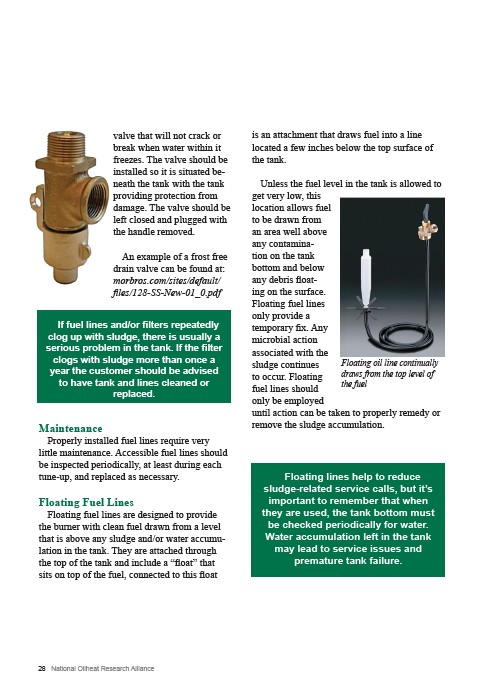
valve that will not crack or
break when water within it
freezes. The valve should be
installed so it is situated beneath
the tank with the tank
providing protection from
damage. The valve should be
left closed and plugged with
the handle removed.
An example of a frost free
drain valve can be found at:
morbros.com/sites/default/
files/128-SS-New-01_0.pdf
Maintenance
Properly installed fuel lines require very
little maintenance. Accessible fuel lines should
be inspected periodically, at least during each
tune-up, and replaced as necessary.
Floating Fuel Lines
Floating fuel lines are designed to provide
the burner with clean fuel drawn from a level
that is above any sludge and/or water accumulation
in the tank. They are attached through
the top of the tank and include a “float” that
sits on top of the fuel, connected to this float
28 National Oilheat Research Alliance
is an attachment that draws fuel into a line
located a few inches below the top surface of
the tank.
Unless the fuel level in the tank is allowed to
get very low, this
location allows fuel
to be drawn from
an area well above
any contamination
on the tank
bottom and below
any debris floating
on the surface.
Floating fuel lines
only provide a
temporary fix. Any
microbial action
associated with the
sludge continues
Floating oil line continually
to occur. Floating
draws from the top level of
fuel lines should
the fuel
only be employed
until action can be taken to properly remedy or
remove the sludge accumulation.
If fuel lines and/or filters repeatedly
clog up with sludge, there is usually a
serious problem in the tank. If the filter
clogs with sludge more than once a
year the customer should be advised
to have tank and lines cleaned or
replaced.
Floating lines help to reduce
sludge-related service calls, but it’s
important to remember that when
they are used, the tank bottom must
be checked periodically for water.
Water accumulation left in the tank
may lead to service issues and
premature tank failure.